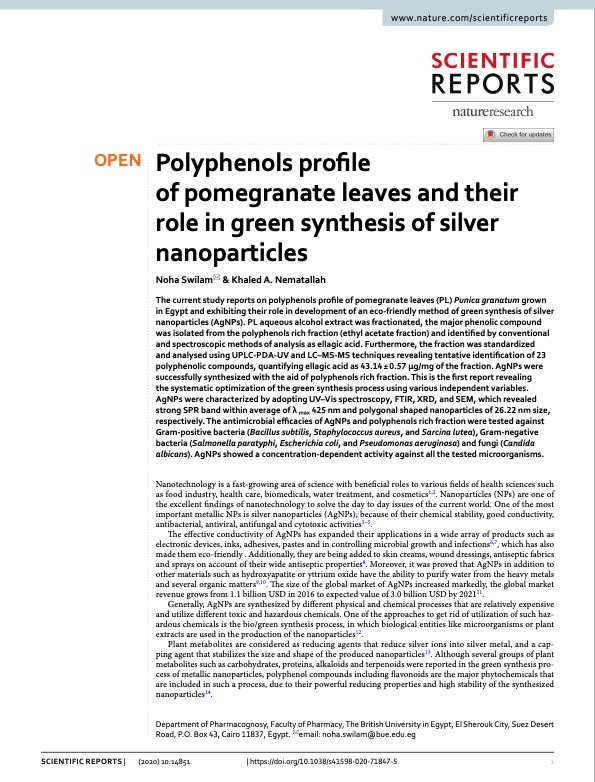
PDF Publication Title:
Text from PDF Page: 001
www.nature.com/scientificreports open Polyphenols profile of pomegranate leaves and their role in green synthesis of silver nanoparticles noha Swilam* & Khaled A. nematallah The current study reports on polyphenols profile of pomegranate leaves (PL) Punica granatum grown in egypt and exhibiting their role in development of an eco-friendly method of green synthesis of silver nanoparticles (AgNPs). PL aqueous alcohol extract was fractionated, the major phenolic compound was isolated from the polyphenols rich fraction (ethyl acetate fraction) and identified by conventional and spectroscopic methods of analysis as ellagic acid. Furthermore, the fraction was standardized and analysed using UPLC-PDA-UV and LC–MS-MS techniques revealing tentative identification of 23 polyphenolic compounds, quantifying ellagic acid as 43.14 ± 0.57 μg/mg of the fraction. AgNPs were successfully synthesized with the aid of polyphenols rich fraction. This is the first report revealing the systematic optimization of the green synthesis process using various independent variables. AgNPs were characterized by adopting UV–Vis spectroscopy, FTIR, XRD, and SEM, which revealed strong SPR band within average of λ max 425 nm and polygonal shaped nanoparticles of 26.22 nm size, respectively. The antimicrobial efficacies of AgNPs and polyphenols rich fraction were tested against Gram-positive bacteria (Bacillus subtilis, Staphylococcus aureus, and Sarcina lutea), Gram-negative bacteria (Salmonella paratyphi, Escherichia coli, and Pseudomonas aeruginosa) and fungi (Candida albicans). AgNPs showed a concentration-dependent activity against all the tested microorganisms. Nanotechnology is a fast-growing area of science with beneficial roles to various fields of health sciences such as food industry, health care, biomedicals, water treatment, and cosmetics1,2. Nanoparticles (NPs) are one of the excellent findings of nanotechnology to solve the day to day issues of the current world. One of the most important metallic NPs is silver nanoparticles (AgNPs); because of their chemical stability, good conductivity, antibacterial, antiviral, antifungal and cytotoxic activities3–5. The effective conductivity of AgNPs has expanded their applications in a wide array of products such as electronic devices, inks, adhesives, pastes and in controlling microbial growth and infections6,7, which has also made them eco-friendly . Additionally, they are being added to skin creams, wound dressings, antiseptic fabrics and sprays on account of their wide antiseptic properties8. Moreover, it was proved that AgNPs in addition to other materials such as hydroxyapatite or yttrium oxide have the ability to purify water from the heavy metals and several organic matters9,10. The size of the global market of AgNPs increased markedly, the global market revenue grows from 1.1 billion USD in 2016 to expected value of 3.0 billion USD by 202111. Generally, AgNPs are synthesized by different physical and chemical processes that are relatively expensive and utilize different toxic and hazardous chemicals. One of the approaches to get rid of utilization of such haz- ardous chemicals is the bio/green synthesis process, in which biological entities like microorganisms or plant extracts are used in the production of the nanoparticles12. Plant metabolites are considered as reducing agents that reduce silver ions into silver metal, and a cap- ping agent that stabilizes the size and shape of the produced nanoparticles13. Although several groups of plant metabolites such as carbohydrates, proteins, alkaloids and terpenoids were reported in the green synthesis pro- cess of metallic nanoparticles, polyphenol compounds including flavonoids are the major phytochemicals that are included in such a process, due to their powerful reducing properties and high stability of the synthesized nanoparticles14. Department of Pharmacognosy, Faculty of Pharmacy, The British University in Egypt, El Sherouk City, Suez Desert Road, P.O. Box 43, Cairo 11837, Egypt. *email: noha.swilam@bue.edu.eg (2020) 10:14851 | https://doi.org/10.1038/s41598-020-71847-5 1 Vol.:(0123456789) Scientific RepoRtS |PDF Image | pomegranate leaves and their role in green silver nanoparticles

PDF Search Title:
pomegranate leaves and their role in green silver nanoparticlesOriginal File Name Searched:
s41598-020-71847-5.pdfDIY PDF Search: Google It | Yahoo | Bing
Turbine and System Plans CAD CAM: Special for this month, any plans are $10,000 for complete Cad/Cam blueprints. License is for one build. Try before you buy a production license. More Info
Waste Heat Power Technology: Organic Rankine Cycle uses waste heat to make electricity, shaft horsepower and cooling. More Info
All Turbine and System Products: Infinity Turbine ORD systems, turbine generator sets, build plans and more to use your waste heat from 30C to 100C. More Info
CO2 Phase Change Demonstrator: CO2 goes supercritical at 30 C. This is a experimental platform which you can use to demonstrate phase change with low heat. Includes integration area for small CO2 turbine, static generator, and more. This can also be used for a GTL Gas to Liquids experimental platform. More Info
Introducing the Infinity Turbine Products Infinity Turbine develops and builds systems for making power from waste heat. It also is working on innovative strategies for storing, making, and deploying energy. More Info
Need Strategy? Use our Consulting and analyst services Infinity Turbine LLC is pleased to announce its consulting and analyst services. We have worked in the renewable energy industry as a researcher, developing sales and markets, along with may inventions and innovations. More Info
Made in USA with Global Energy Millennial Web Engine These pages were made with the Global Energy Web PDF Engine using Filemaker (Claris) software.
Infinity Turbine Developing Spinning Disc Reactor SDR or Spinning Disc Reactors reduce processing time for liquid production of Silver Nanoparticles.
| CONTACT TEL: 608-238-6001 Email: greg@infinityturbine.com | RSS | AMP |